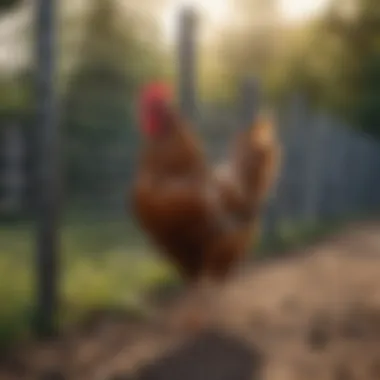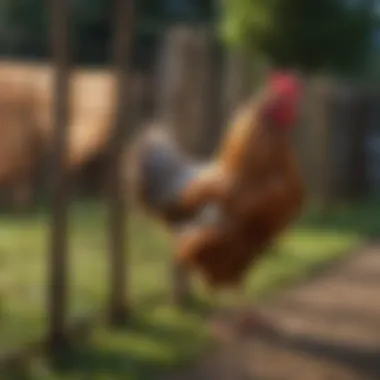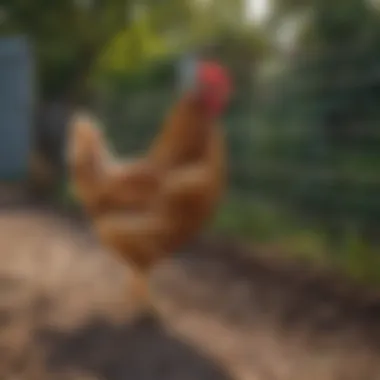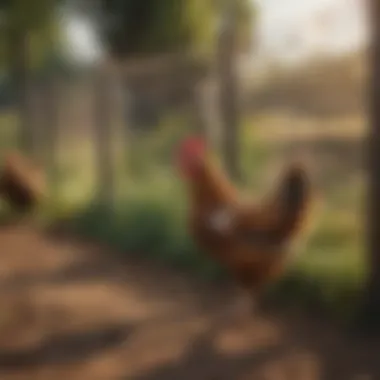Understanding the 6 ft Poultry Fence: Design and Benefits


Intro
A 6 ft poultry fence serves as a critical component in maintaining the safety and well-being of poultry. It is vital for both the protection of the birds and the peace of mind of their keepers. The decision to use a fence of this height is not merely a matter of dimension; it involves understanding the specific needs of the birds, potential predators, and the environment in which they are housed.
This article aims to provide an in-depth examination of the various aspects associated with a 6 ft poultry fence. We will explore specific materials that are best suited for this type of fencing, effective installation techniques, necessary maintenance, and the challenges that may arise. By doing so, we hope to equip poultry enthusiasts with the knowledge to make informed choices when it comes to fencing solutions, ensuring a secure and conducive living space for their birds.
Design Considerations
The design of a poultry fence is paramount. Height is a significant factor because it not only prevents birds from escaping but also deters various predators like raccoons and foxes. A 6 ft fence is generally adequate for most domestic poultry, but the design should include a sturdy base to prevent digging.
Material Selection
Selecting the right material for your fence will impact its durability and effectiveness. Common options include:
- Welded wire mesh: Known for its strength and longevity.
- Chain link: Offers excellent visibility but may not be as secure as welded wire.
- Wood fencing: Aesthetic, but requires regular maintenance to prevent decay.
The choice of material will depend on local environmental conditions, such as humidity and temperature fluctuations. It's also essential to choose materials that blend well with the surrounding landscape.
Installation Techniques
Installation of a 6 ft poultry fence can be done through careful planning and methodical execution.
- Planning the Layout: Survey the area and decide where the fence will be located.
- Setting Posts: Use treated wood or metal for durability. Ensure they are securely anchored in the ground to withstand pressure from the birds and elements.
- Attaching the Material: Depending on the selected material, you will need different tools. For chain link, special ties may be needed. Welded wire will require help from fencing staples.
- Final Inspection: Ensure there are no gaps around the base or corners where birds might escape or predators gain entry.
Involving friends or a local fencing expert can streamline this process.
Maintenance Requirements
Regular maintenance is crucial for the longevity of your poultry fence. Some key steps include:
- Checking for damage: Periodically inspect the fence for any wear or breaches.
- Cleaning the area: Remove debris to prevent harboring pests.
- Checking soil erosion: Ensure the ground remains stable around the base.
Such tasks can be scheduled monthly or bi-monthly depending on environmental factors.
Challenges Faced by Poultry Keepers
While a 6 ft poultry fence provides security, there are challenges to consider.
Preface to Poultry Fencing
Poultry fencing serves as a fundamental element in the management of farm and backyard flocks. Proper fencing is not merely a barrier; it defines the safety of your poultry, safeguards them from predators, and establishes a structured environment for their growth. The landscape of poultry keeping can be vastly different based on various factors, including breed, geographical location, and specific challenges posed by local wildlife. Therefore, understanding the nuances of fencing is crucial for any poultry owner.
Importance of Proper Fencing
Creating appropriate enclosures is vital in poultry management. The primary purpose of fencing is to prevent unwanted animals from entering the area where poultry roam. This is particularly important for breeds that are more susceptible to theft or predation, such as chickens and ducks. Inadequate fencing may result in significant losses, both financially and emotionally. Thus, investing in robust and effective fencing should be a top priority for poultry keepers.
Additionally, proper fencing helps contain your flock. By providing them with a defined area, you reduce the risk of them wandering off and potentially encountering dangers such as roads or other animals. This containment fosters a controlled environment where you can monitor their behaviors and health more effectively.
Overview of Fence Height Considerations
When selecting fencing, height is a significant factor to consider. Depending on the breed of poultry and the types of predators in the surrounding area, taller fencing can often provide better protection. A six-foot fence offers a practical balance. The elevation can deter many common threats such as raccoons, dogs, and even some larger birds of prey.
However, it is essential to consider the specific characteristics of your environment. Are there frequent reports of wildlife encounters? Or perhaps your chickens tend to fly? In these cases, a higher fence might be advisable. Conversely, in more urban settings where the risks are lower, a shorter fence might suffice. Ultimately, the decision should be informed by assessment of both the birds' abilities and the local risks.
Effective fencing does not only serve as a barrier; it directly influences the welfare and productivity of your poultry.


Characteristics of ft Poultry Fences
The characteristics of a 6 ft poultry fence hold significant weight in ensuring the effectiveness and functionality of poultry containment. By exploring design features, material options, and durability, one can understand how a properly constructed fence enhances both security and comfort for poultry. It can serve as a critical barrier against predators and unwanted intrusions, while also offering a spacious environment for the birds.
Design Features
A well-thought-out design is a cornerstone of effective poultry fencing. A 6 ft fence typically features a height that deters most predators such as foxes and raccoons. Additionally, the design may include a slight overhang or angled top to prevent climbing.
Design elements like solid gates, and small entry points are crucial for maintaining security. The visual impact is also relevant; ideally, the fence blends with the natural surroundings which can ease stress for the birds. Additionally, the spacing of the fencing materials plays a vital role in keeping smaller animals out while allowing enough visibility for the poultry.
Material Options
Wire Fencing
Wire fencing is one of the most common choices for poultry containment. Its defining characteristic is its strong, flexible structure that can withstand elements effectively. It allows air circulation, which keeps the environment more comfortable for the birds. Moreover, wire fencing can be tailored to include smaller mesh sizes at the bottom, providing further protection against smaller predators. However, it can sometimes rust over time if not treated correctly, which can be a disadvantage in certain environments.
Wooden Fencing
Wooden fencing is favored for its aesthetic appeal and sturdiness. It provides solid barriers that are difficult for predators to breach. The primary feature of wooden fencing lies in its ability to be customized easily to fit various landscapes. Its natural materials can integrate well into rural settings. However, wooden fences may require more maintenance than others as they can be susceptible to rot and insect damage if not properly treated from the start.
Composite Fencing
Composite fencing, made from a combination of wood fibers and plastic materials, offers a modern solution. The key characteristic of composite fencing is its durability and low maintenance needs. This type of fencing does not warp, splinter, or rot like traditional wood. Moreover, its design allows for easy installation. Its unique feature is that it can come in various colors and styles, appealing to those who are conscious about aesthetics. The major downside is the higher initial cost compared to other types, yet its longevity often justifies the investment.
Durability and Lifespan
Durability is a prime consideration in choosing a poultry fence. Various materials contribute to the lifespan of the fence. Wire can last for many years if it's galvanized, while wood may need replacement or treatment every few years to maintain integrity. Composite materials generally offer the longest lifespan but come with higher upfront costs. Evaluating the environment and the specific needs of poultry will dictate the best choice for durability and longevity.
Proper fencing ensures the safety of your poultry, while also providing them with adequate space to move and thrive.
Installation Process
The installation process of a 6 ft poultry fence is crucial for ensuring effective containment and safety for your poultry. Proper installation not only enhances security but also prolongs the fence's lifespan. A well-installed fence contributes to the stability of the structure and ensures that the designated area remains predator-proof. Understanding this process helps poultry keepers avoid common mistakes, saving both time and resources.
Site Preparation
Before starting the actual installation, site preparation is a key step. This phase involves selecting the right location and ensuring the ground is ready for your fence. Start by identifying the perimeter of the area where you plan to install the fence. Mark the corners and run strings or stakes along the sides to visualize the layout. Remove any debris, rocks, or plants that might obstruct the installation. Leveling the uneven ground can significantly ease the installation process. This preparation is essential for the stability of the fence and helps in providing a clear understanding of how it will fit in the surrounding environment.
Tools Required
Having the right tools at hand is vital for a smooth installation. Below is a list of necessary tools:
- Post hole digger: For digging holes for the fence posts.
- Tape measure: To measure distances accurately.
- Level: To ensure posts are straight.
- Hammer: For driving in stakes and securing materials.
- Wire cutters: To cut fencing material as needed.
- Pliers: Useful for securing wire fencing.
- Safety gloves: To protect your hands during installation.
Make sure to gather these tools before beginning to save time and avoid any interruptions during the process.
Step-by-step Installation
The actual installation can be broken down into several manageable steps:
- Prepare your fence posts: Cut the posts to your desired height, usually 6 ft, and ensure they are treated to resist rot.
- Dig post holes: Following the marked layout, dig holes at least 2 feet deep to provide adequate support.
- Set the posts: Place the posts into the holes and fill with concrete for stability. Check that they are level before allowing the concrete to set.
- Attach the fencing material: Depending on your choice of fencing (wire, wood, etc.), start attaching it from one end to the other, ensuring it is taut and secured firmly.
- Secure fencing to posts: Use brackets or ties to attach the fencing material to the posts, confirming that it remains tight and firm.
- Install gates: If applicable, install gates at designated entry points, ensuring they match the height of your fence.
- Final checks: After everything is in place, walk around the fence to ensure there are no gaps or loose sections, providing a thorough check of its integrity and stability.
Following these steps will ensure a sturdy and long-lasting 6 ft poultry fence that will guard your poultry effectively.
Benefits of a ft Poultry Fence


A 6 ft poultry fence offers distinct advantages for those engaged in the care of chickens, ducks, or other fowl. The discussion of benefits must highlight specific elements that show its importance in maintaining an efficient, safe, and versatile environment for poultry. Understanding these benefits allows keepers to appreciate both the practical and strategic dimensions of investing in such a structure.
Predator Protection
One of the foremost reasons for erecting a 6 ft poultry fence is its effectiveness in protecting against predators. The height can deter many common threats including raccoons, foxes, and dogs. Higher fences present more of a challenge for these animals, often preventing them from jumping over, especially if the proper installation methods are used.
- Adding additional deterrents, such as barbed wire or electric fencing at the top, further increases security.
- Always consider the local wildlife in your area, as certain predators might require different solutions.
Proper predator protection not only safeguards the poultry but also assures a more peaceful and stress-free environment for the birds.
“Investing in a sturdy fence is investing in the welfare of your flock.”
Space and Mobility
A 6 ft fence offers ample height for poultry to move freely without feeling overly confined. The vertical space allows for natural behaviors like stretching wings, jumping, and even perching.
- Space can affect the health and comfort of the birds. If the birds have room to move and display natural behaviors, they are less likely to experience stress.
- Facilitating some space outside the immediate enclosure can also allow for foraging opportunities, vital for a chicken's diet.
For poultry keepers, it is critical to strike a balance between freedom and security. The 6 ft height serves this purpose effectively.
Versatility for Different Poultry Types
Not all poultry have the same needs or behaviors. A 6 ft poultry fence is versatile enough to cater to different types of birds, from chickens to ducks or even geese. Each species may require distinct considerations.
- Chickens benefit from taller fences as they are robust foragers and can fly short distances.
- Ducks, known for their tendency to wander, also benefit from a higher enclosure, as they are less prone to try flying over fences than chickens but can still manage to escape if the fence is too low.
Depending upon the specific breed, utilizing a 6 ft fence can align with other husbandry needs, ensuring the safety and convenience of keeping various types of poultry under one structure. The adaptability of a 6 ft fencing system enhances its appeal and effectiveness in diverse scenarios.
Maintenance and Care
Maintenance and care for a poultry fence are critical to ensuring the security and health of your birds. A well-maintained fence prevents threats from predators and ensures that the poultry stay safely contained within their designated area. Regular upkeep not only prolongs the lifespan of the fence but also guarantees optimal performance across various conditions. Here we discuss specific elements such as inspections, repairs, and cleaning that contribute to effective maintenance.
Regular Inspections
Conducting regular inspections is vital for the safety and effectiveness of a 6 ft poultry fence. These inspections should occur at least once a month, or more frequently in adverse weather conditions. This process involves checking the integrity of the entire structure.
Some key areas to focus on include:
- Check for Loose Fencing: Ensure that the fencing is securely fastened to posts and has no gaps that could allow animals to escape or intruders to enter.
- Examine the Ground: Look for signs of digging. Animals may try to burrow under the fence, especially near the corners.
- Inspect for Wear and Tear: Look for rust, corrosion, or physical damage to the fencing material. Any damaged areas should be noted for repair.
Regular inspections can be the difference between safety and loss. Noticing small issues early can prevent larger problems later.
Repairing Damage
When irregularities or damage are identified, swift action is necessary. Prompt repairs are essential to maintain the fence's protective capabilities. Many types of damage can occur, including:
- Torn Wire: This can happen from abrasion or from animals trying to get through. Repair can involve using wire cutters and pliers to replace faulty segments.
- Broken Posts: Support posts can become unstable. Replacing or reinforcing them is crucial to maintain the structure's integrity.
- Panel Separation: Sections of fencing might start to come apart. Reattaching these to the main frame is important to keep the entire fence secure.
A well-repaired fence not only protects your poultry but also enhances the overall appearance of your setup.
Cleaning Techniques
Keeping the poultry fence clean is another essential component of maintenance. Debris accumulation and dirt can affect the longevity of the materials used. Regular cleaning can be done in a few simple steps:
- Remove Debris: Clear any leaves, grass, or other materials that may accumulate at the base or around the fencing structure.
- Power Wash or Scrub: For wire fencing, a power washer or stiff brush can help remove buildup. For wood, gentle scrubbing can be effective—avoid harsh chemicals that could harm the material.
- Inspect After Cleaning: This is an excellent opportunity to inspect for damage. Look for any changes in the fence condition after removing the dirt and grime.


A clean fence is not only more visually appealing but also reduces the risk of pests and bacteria that could affect the health of your poultry. Overall, maintenance and care must remain a priority to create a safe environment for your birds.
Challenges and Solutions
Common Problems with Poultry Fences
Poultry fencing, especially the 6 ft variant, is generally reliable. However, certain issues can arise during its use. Understanding these challenges is essential for maintaining a secure environment for poultry. One common problem is the potential for predators. Animals like foxes, raccoons, and hawks often target chickens and other poultry. If the fence is not properly installed or maintained, it may be breached, leading to significant losses.
Another issue is wear and tear. Over time, natural elements can affect the fence's integrity. Factors such as extreme weather, rust, or insect damage can compromise fencing materials. For instance, wooden fences may rot, and metallic ones can rust, leading to structural failure.
Additionally, the adaptability of poultry to their fenced environment can present challenges. Birds may emerge as escape artists. They can find weak points or gaps in the fencing, especially if not carefully monitored. Understanding these common problems allows poultry keepers to anticipate and address them.
Mitigation Strategies
To effectively manage the challenges of poultry fencing, specific strategies are necessary. Foremost among them is evaluating and reinforcing the fence's structural integrity. Here are a few methods:
- Regular Inspections: Conduct routine checks for any signs of damage from weather or animals. This includes looking for rust, rot, or holes.
- Strengthening the Base: Burrowing predators can be deterred by installing fencing at least a foot underground. This makes it harder for them to dig underneath.
- Installing Overhangs: Adding an overhang can prevent birds from flying over the fencing. This is particularly useful for feathered escapees.
- Choosing Durable Materials: Selecting high-quality materials, such as galvanized steel or treated wood, increases the lifespan of the fencing. These materials resist degradation better than others.
- Electric Fencing: For added protection against determined predators, integrating electric fencing along the top or bottom can be effective. It introduces a deterrent for animals that may challenge the physical barriers.
By being proactive and implementing these strategies, poultry keepers can significantly minimize the likelihood of issues arising with their fencing. Consistent maintenance is crucial for sustaining a secure environment.
Employing these methods helps mitigate common problems associated with poultry fencing. It ultimately enhances the safety and well-being of the birds while ensuring peace of mind for their caretakers.
Comparison with Other Fence Heights
Understanding how the 6 ft poultry fence compares to other heights is essential for any poultry owner. Choosing the right fence height has significant implications for both the safety of your birds and the management of your space. A fence that is too low might allow predators easy access, while one that is too high could create challenges in managing your poultry effectively.
ft vs ft Fencing
When comparing 4 ft and 6 ft fencing, several factors must be considered. Protection against predators is a primary concern. A 6 ft fence provides better security, deterring common predators like raccoons and coyotes. In contrast, a 4 ft fence may be adequate for smaller, less determined animals, but it often proves insufficient in areas with larger threats.
Another aspect is the activity level of the poultry. Chickens and other birds can be quite agile and can attempt to fly over lower fences. The height of 6 ft offers a safeguard in case your birds are tempted to roam outside their designated area. A 4 ft fence may encourage skittish birds to try escaping, which can lead to stress and potential injury.
In terms of cost and installation, 4 ft fencing might be more economical and easier to install, but it could result in higher overall costs if predators breach it. Therefore, the initial savings might not justify the risk.
It's critical to assess your specific environment and the types of threats that may be present when making your decision on fencing height.
Choosing the Right Height for Your Needs
Selecting the correct height for your poultry fencing requires careful consideration of various elements unique to your situation. Key factors include:
- Type of Poultry: Different birds have varying levels of agility. Larger breeds might require taller fences due to their ability to jump or fly.
- Predator Presence: Assessing the local wildlife helps in determining how high your fence should be. If you live in an area with many birds of prey or ground predators, a 6 ft fence is likely the more prudent choice.
- Available Space: The dimensions of your property can also influence decisions. In smaller spaces, higher fences may feel more confining, prompting some owners to prefer shorter options.
- Aesthetic Considerations: If your property is visible to neighbors or the public, your preference regarding visuals and landscaping may affect your choice.
Ultimately, the decision on fence height should harmonize your needs with practical considerations. Balancing safety with ease of management is vital for maintaining a content chicken flock and optimizing their living conditions.
Epilogue
The conclusion holds significant value in this article as it encapsulates the essence of maintaining a secure and effective poultry environment. A 6 ft poultry fence serves not only as a barrier against predators but also as a facilitator of healthy poultry management. The final insights drawn from previous sections will highlight the critical aspects of materials, installation processes, and maintenance of these fences.
Reflecting on the advantages discussed, a 6 ft poultry fence maximizes space efficiency while providing mobility for your birds. This design height is also effective against various predators, thus ensuring your poultry's safety and well-being. By understanding these factors, poultry keepers can make informed decisions that lead to enhanced living conditions for their animals.
Summary of Key Points
In summary, several key points emerge related to the utility of 6 ft poultry fences:
- Predator Prevention: A robust 6 ft fence minimizes the risk of many common predators, ensuring the safety of your flock.
- Material Diversity: Choosing between wire, wood, or composite materials affects durability and style. Each option offers unique benefits that cater to different needs.
- Installation Insights: Proper installation is critical for maximizing the fence's effectiveness. Following a step-by-step guide ensures the structure remains stable over time.
- Maintenance and Care: Regular inspections and prompt repairs help extend lifespan, maintaining the integrity and performance of the fence.
- Adaptability: The versatility in design facilitates accommodation for various poultry types, making it an excellent choice regardless of the flock size or breed.
Final Thoughts on Choosing a ft Poultry Fence
Choosing the right poultry fence is a decision that requires thoughtful consideration. A 6 ft poultry fence stands out because it effectively combines security and practicality. While cost may vary based on materials and installation complexity, the benefits often outweigh expenses in the long run.
Poultry enthusiasts should assess their specific needs, local wildlife threats, and potential changes in flock dynamics. By investing in a suitable fence, the keeper not only protects their poultry but also promotes a healthy and productive environment. In essence, a 6 ft poultry fence is more than just a physical barrier; it represents a commitment to the safety and welfare of one’s flock.







